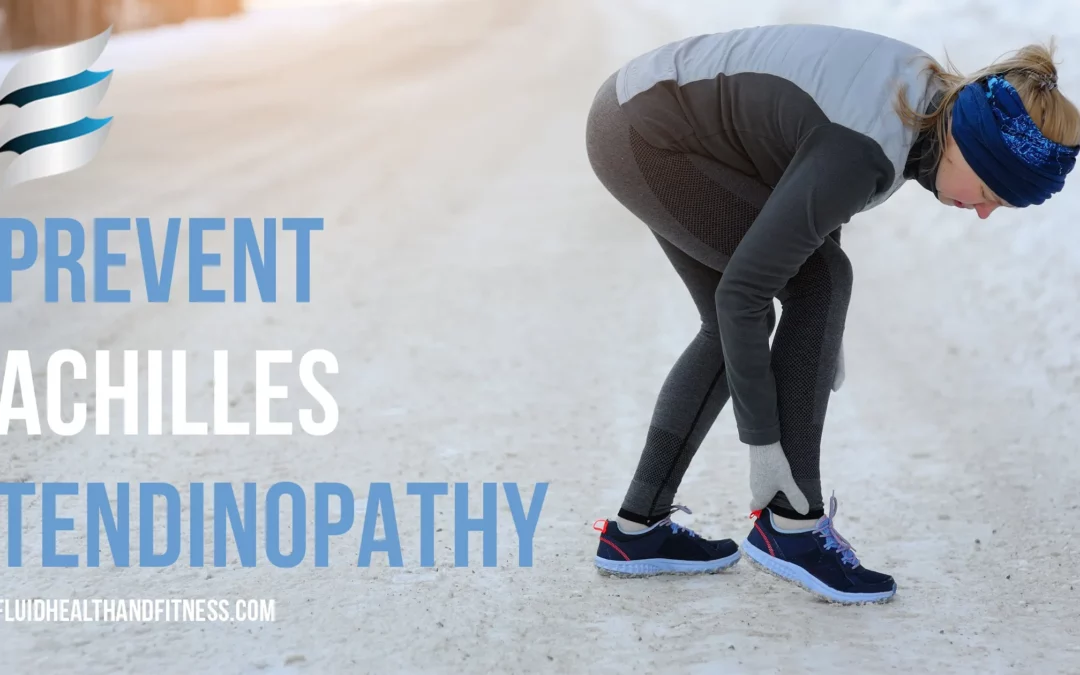Another very common overuse injury found in athletes like runners and cross country skiers is achilles tendinopathy. It is estimated that the annual incidence of achilles tendinopathy is 7-9% and occurs most frequently in the athletic population of 30-50 year olds. Multiple studies also suggest males are more likely than females to have an incident of this injury.
This pain is typically felt in the midportion of the achilles with activities like running, jumping or activities like cross country skiing where you need to propel your body forward.
As with most cases of achilles tendinopathy, multiple contributing factors play a role in its formation.
According to more recent studies, achilles tendinitis is more often accurately described as a tendinopathy as it is no longer necessarily just viewed as an issue of tendon inflammation.
Instead, there have been noted pathological changes at the tendon itself, outside of simply inflammation.
Some of these changes are similar to what is seen in plantar fasciitis where the tendon thickens due to tenocyte proliferation. Other observed changes include: neovascularity, collagen fibril thinning and disorganization, fat deposition, collagen fibril thinning and disorganization, altered fluid movement and nitric acid overproduction.
WHAT’S THE BIG DEAL?
Well, all of these changes can lead to mechanical failure of the tendon leading to decreased tendon stiffness and strength and…
PAIN.
Some studies even suggest local cell death occurs due to these intrinsic changes in and around the tendon.
EVEN MORE,
There are some studies that point to genetic predisposition to achilles injuries, though this is not fully understood.
SO WHAT CAUSES THIS IN THE FIRST PLACE?
Well, like most overuse injuries, a recent significant increase in training load can be the culprit as tissue tolerance can not handle the current workload.
Or like with plantar fasciitis, a limitation in ankle dorsiflexion range of motion puts more stress and strain on the achilles tendon as it is lengthened and/or controlling or producing force.
AND WHAT CAN YOU DO TO AVOID THIS?
Again, follow a periodized training schedule to introduce appropriate workload to ensure tissues safely and readily form meaningful adaptations over time.
This will help you to avoid overloading the tendon.
SECONDLY,
IMPROVE ANKLE RANGE OF MOTION.
Active and/or passive range of motion deficits in ankle dorsiflexion is associated strongly with achilles tendinopathy.
To review, this is the motion of pulling your ankle/toes up toward you.
If tightness/stiffness is present…
These deficits can lead to excessive stress transmitted through the foot or achilles which may eventually thicken (as seen on ultrasounds) and cause pain.
The range of motion restrictions can also cause shortened stride lengths, thus decreasing your overall performance.
Stretches that incorporate the windlass mechanism of your foot are also helpful.
IN ADDITION…
The inefficient way ground reaction force is transmitted through an ankle with limited dorsiflexion mobility can lead to GLOBAL MOVEMENT COMPENSATIONS up the chain at the knees and/or hips and eventually cause other issues and pain.
LET’S ADD ANOTHER ACTIVITY.
Your balance and ability to support a neutral arch is important.
Over pronation or toeing-out has been associated with increased risk of achilles tendinopathy.
If one cannot perform this simple exercise in a controlled environment where there is no dynamic activity or changes in center of mass, how can one expect to be able to control this when much higher demands are introduced to the body?
YOU CANNOT!
You would not believe how difficult this is for most individuals.
Simple single leg balance activities while maintaining a neutral arch are a great place to start.
Once this is mastered, appropriate progressions can be made to increase the challenge and improve the simulation of related activities.
A prevention program would not be complete without incorporating eccentric (negative) heel raises and general sport strengthening like lunges/deadlifts/squats/split squats.
Raising your body up on your toes then slowly controlling the downward motion has been shown to introduce the necessary stimuli for the achilles tendon to heal and/or prevent injury.
THERE ARE SIMPLE PROGRESSIONS OF THIS EXERCISE.
Up with 2, down with 2.
Up with 2, down with 1.
Up with 1, down with 1.
Adding resistance/weight.
2-3 sets of 25-30 repetitions.
And finally, adding in some plyometric/power type exercises like pogo jumps (knees remain straight while you jump) or explosive split squat jumps.
With these changes made, your body will be able to more efficiently move and transmit the forces required for your activity.
Thus, decreasing the likelihood of achilles tendinopathy.
AND BETTER YET…
IMPROVING PERFORMANCE!
As always, in the case that these changes do not help, there are more individualized treatment options available like manual therapy/mobilizations and other modalities that a skilled physical therapist or movement specialist may be able to assist with.
AND REMEMBER…
YOUR BODY WAS DESIGNED TO MOVE!
- Martin RL, Chimenti R, Cuddeford T, Houck J, Matheson JW, McDonough CM Paulseth S, Wukich DK, Carcia CR. Achilles Pain, Stiffness, and Muscle Power Deficits: Midportion Achilles Tendinopathy Revision 2018 Clinical Practice Guidelines Linked to the International Classification of Functioning, Disability and Health From the Orthopaedic Section of the American Physical Therapy Association J Orthop Sports Phys Ther. 2018;48(5):A1-A38. doi:10.2519/jospt.2018.0302
- Sobhani S, Dekker R, Postema K, Dijkstra PU. Epidemiology of ankle and foot overuse injuries in sports: a systematic review. Scan J Med Sci Sports. 2013;23:669-686
- Magnussen RA, Dunn WR, Thomson AB. Nonoperative treatment of midportion achilles tendinopathy: a systematic





